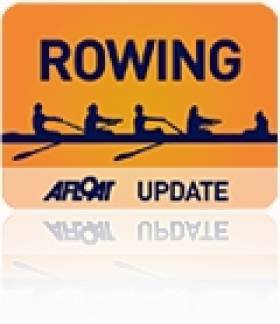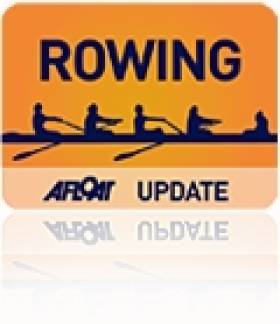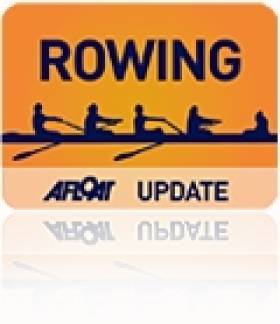Displaying items by tag: Head of the River
Good Day For St Joseph's Rowers at Castleconnell Head of the River
# ROWING: St Joseph’s of Galway had a good day at the Castleconnell/Bulls and Bears head of the river on the Shannon on Saturday. The Junior 18A eight from the school was the fastest crew and the Junior 18A quadruple also won.
Castleconnell Bulls and Bears Head of the River, Saturday (Selected Results)
Men
Eight – Junior 18A: 1 St Joseph’s 10:06, 2 St Joseph’s B 10:14, 3 Col Iognaid 10:45. Junior 16: 1 St Joseph’s 10:56, 2 St Joseph’s B 11:06, 3 Col Iognaid 11:13. Masters: Shannon C 11:42.
Four – Intermediate One, Coxed: 1 Col Iognaid 11:29, 2 Fossa 11:34, 3 St Michael’s 11:52.
Pair – Senior: 1 St Michael’s G 11:15, 2 St Michael’s E 11:19, 3 Castleconnell/Clonmel 11:36. Junior 18A: 1 Clonmel 11:59, 2 Presentation Col 12:45, 3 Commercial 12:54.
Sculling, Quadruple, coxed – Junior 18A: 1 St Joseph’s 10:14, 2 Athlone 10:48, 3 Presentation Col 10:58. Junior 16: 1 Commercial 11:24, 2 Clonmel 11:27, 3 Presentation Col 11:39.
Double – Intermediate: 1 St Michael’s 11:13, 2 Garda 11:28, 3 St Michael’s B 11:40. Junior 18A: 1 Commercial B 12:13, 2 Commercial A 12:18, 3 Presentation Col B 12:28. Junior 16: 1 Castleconnell 11:57, 2 Clonmel 12:05, Athlone 12:05.
Single – Senior: 1 Commercial (D’Estelle Roe) 12:12, 2 Commercial (Gleeson) 12:32, 3 Offaly (O’Donoghue) 13:15. Intermediate One: 1 St Michael’s (Lazda) 12:29, 2 Commercial (Yeomans) 12:30, 3 University of Limerick (Haugh) 12:34. Novice: 1 Clonmel (Murphy) 12:44, 2 Clonmel (Chadfield) 12:57, 3 Offaly (Gannon) 13:52. Junior 18A: 1 Athlone (Molloy) 12:16, 2 Commercial (Yeomans) 12:31, 3 Commercial (Yeomans) 12:37, 4 St Michael’s (Despard) 12:37. Masters: Offaly (Hussey) 13:17. Junior 16: 1 St Michael’s (O’Malley) 12:05, 2 Neptune (Flynn) 12:45, 3 St Michael’s (O’Connor) 12:49.
Women
Eight – Novice: 1 Commercial 13:29, 2 Univ of Limerick B 14:43. Junior 18A: 1 Shannon 11:36, 2 Commercial 13:11, 3 Castleconnell 13:29. Junior 16: 1 Shannon 12:40, 2 Shannon B 12:51, 3 Commercial 15:39.
Four – Novice, coxed: 1 Commercial 12:52, 2 Athlone 13:32, 3 Commercial B 16:20.
Pair – Junior: Commercial 14:45.
Sculling
Junior 16, coxed: 1 St Michael’s B 12:58, 2 Col Iognaid 13:18, 3 St Michael’s F 13:19.
Double – Junior 18A: 1 St Michael’s E 13:07, 2 Commercial 13:16, 3 Clonmel 13:43. Junior 16: 1 Col Iognaid 13:37, 2 Tralee B 13:57, 3 Offaly 14:34.
Single – Intermediate: 1 Commercial (Foley) 13:39, 2 St Michael’s (McEvoy) 13:48, 3 Garda (Holden) 14:38. Novice: 1 Commercial (Foley) 13:58, 2 Shannon (Ryan) 14:27, 3 Univ of Limerick (O’Sullivan) 14:56. Junior 18A: 1 Commercial (Rodger) 14:14, 2 St Michael’s B (Sheehan) 14:36, 3 Castleconnell (Donegan) 14:42. Junior 16: 1 Commercial (Lambe) 14:00, 2 St Michael’s (Murphy) 14:05, 3 Castleconnell (Griffin) 14:31.
Kenny Fastest Single Sculler at Neptune Head of River Rowing
# ROWING: The Neptune Head of the River at Blessington gave Niall Kenny and some other top Galway rowers a chance to blow off the cobwebs in the run-up to the National Assessment in two weeks’ time in Newry. Kenny, a lightweight, won the single sculls well with his effort in the better conditions of the second head.
The honour of being the fastest eight was taken with ease by Trinity – St Michael’s damaged the fin on their boat in the first head and did not do as well as they would have liked in a borrowed boat in the second. Trinity were the women’s eight winners and Marie O’Neill of Cork the fastest women’s single sculler.
Neptune Head of the River, Blessington, Saturday (Selected Results)
Men
Eight – Senior: 1 Trinity (head one) 12 minutes 13 seconds, 2 St Michael’s (head 2) 12:24, 3 St Michael’s (head 1) 13:13. Intermediate: Trinity (2) 12:23, 2 Neptune (1) 13:24, 3 Trinity (2) 16:17. Novice: 1 Trinity (2) 13:31, 2 NUIG (2) 13:40, 3 Trinity (1) 13:42. Junior 18: Neptune (2) 12:39, 2 Neptune (1) 13:39, 3 Cork BC (1) 13:41. Junior 16: 1 Portora (1) 13:26, 2 Neptune (2) 14:03, 3 Commercial (2) 14:24. Masters: Old Collegians (1) 14:17.
Four – Senior: 1 St Michael's 12:51, 2 NUIG A/Grainne Mhaol/UCC (head 1) 13:07, 3 NUIG/St Joseph’s (1) 13:08. Intermediate: 1 NUIG B (2) 13:18, 2 NUIG (2) 13:33, 3 Trinity (1) 13:38. Junior 18: 1 Neptune (1) 14:11. Masters: Old Collegians (1) 14:49.
Sculling,
Double – Senior: 1 Trinity (Flaherty, Hughes) (Head 2) 13:57, 2 Commercial (1) 14:11, 3 Graiguenamanagh (2) 15:24. Single: 1 UCC (N Kenny) (2) 14:48, 2 NUIG (Mullarkey) (2) 15:03, 3 NUIG (S O’Connor) (2) 15:23, 4 Commercial (A Maher) (1) 15:26, 5 University of Limerick (Brinn) (1) 15:42, 6 Commercial (Gleeson) (1) 15:50. Intermediate: 1 NUIG (Egan) (2) 15:34, 2 Neptune (O’Connor) (1) 15:35, 3 St Michael’s (Stundon) (1) 15:45.
Women
Eight – Senior: 1 Trinity (2) 14:09, 2 Trinity (1) 14:26, 3 Trinity B (2) 14:26. Intermediate: Trinity (1) 14:36. Novice: 1 Trinity (1) 16:10, 2 Trinity (2) 16:32, 3 Commercial (2) 16:46Junior: 1 Carrick-on-Shannon (2) 15:25, 2 Portora (2) 15:34, 3 Graiguenamanagh (1) 16:10. Junior 16: 1 Portora (1) 15:32, 2 Carlow (2) 17:02, 3 Portora (2) 17:15.
Four – Senior: 1 Cork BC (2) 14:38, 2 St Michael’s (1) 15:30, 3 Commercial (2) 15:30. Intermediate: 1 NUIG (2) 15:58, 2 NUIG (1) 16:53, 3 NUIG B (1) 16:59.
Sculling
Double – Senior: 1 NUIG (1) 15:42, 2 Three Castles (2) 15:43, 3 St Michael’s (2) 16:05.
Single – Senior: 1 Cork (M O’Neill) (1) 16:45, 2 Three Castles (Quinn) (1) 16:53, 3 Trinity (Cooney) (2) 17:00. Intermediate: 1 Trinity (Dolan) (1) 16:53, 2 Trinity (O’Brien) (1) 17:02, 3 NUIG (Hurst) (2) 17:18.
Keohane Top Single Sculler at Skibbereen Head of the River
#ROWING: John Keohane was the fastest men’s single sculler and Marie O’Neill the fastest woman at the big Skibbereen Head of the River at the National Rowing Centre in Cork on Saturday. Skibbereen’s men’s quadruple scull were the fastest crew of the day, with a winning time of 10 minutes 30 seconds for the 3,800 metres.
Skibbereen Head of the River, National Rowing Centre, Farran Wood, Cork, Saturday (Selected Results)
Head One
Women, Eight – Junior 16: Shannon 13:27.
Quadruple Scull – Senior: Skibbereen 11:36. Intermediate: University of Limerick 13:43. Novice, coxed: Cork 13:30. Junior 18A: Skibbereen 12:01, 2 Shandon 12:12, 3 Castleconnell 12:22.
Head Two
Men
Single Sculls: 1 Lee Valley (J Keohane) 12:01, 2 University of Limerick (Penny) 12:03, 3 Cork IT (O’Donovan) 12:19. Intermediate: 1 Skibbereen (Burns) 12:33, 2 UCC (McGuckin) 12:42, 3 Skibbereen (Leonard) 12:44. Novice: 1 Lee (Keogh) 12:45, 2 Clonmel (Murphy) 13:06, 3 UCC (Stanton) 13:34. Junior 18A: 1 Lee (Mitchell) 12:25, 2 Skibbereen (Ryan) 12:26, 3 Presentation (Keohane) 12:34. H
Head Three
Women, Pair – Senior: Cork 14:23.
Single Scull – Senior: 1 Cork (O’Neill) 13:12, 2 Skibbereen (Walsh) 13:13, 3 Skibbereen (Fitzgerald) 13:44. Intermediate: 1 Lee Valley (K Corcoran-O’Hare) 13:45, 2 Cork (Judge) 14:25, 3 Fermoy (Dowling) 14:35. Novice: 1 University of Limerick (Griffin) 15:13, 2 Lee (McGrath) 15:19, 3 University of Limerick (Mooney) 15:39. Junior 18A: 1 Skibbereen (Walsh) 13:46, 2 Fermoy (Shinnick) 13:47, 3 Cork (Hamel) 14:23. Junior 16: Cork (Beechinor) 14:37.
Head Four
Men, Four, coxed – Junior 18A: Presentation 12:08.
Double Sculls – Senior: 1 Lee Valley 11:18 and Skibbereen/Cork IT 11:18. Intermediate: Skibbereen 11:30. Novice Lee 12:06. Junior 18A: 1 Skibbereen 11:13, 2 Lee 11:16, 3 Shandon 11:30. Junior 16: Skibbereen 11:44.
Head Five
Women, Four – Senior: Cork 11:49. Intermediate, coxed: Shandon 13:06. Novice, coxed: 13:42.
Double Scull – Senior: 1 Skibbereen B 12:35, 2 Skibbereen A 12:36. Intermediate: Killorglin 13:10. Junior 18A: 1 Fermoy 12:40, 2 Graiguenamanagh 13:40, 3 Cork 14:01. Junior 16: Muckross 13:16.
Head Six
Men, Eight – Intermediate: University of Limerick 10:52. Junior 18A: Presentation 10:42. Junior 16: Presentation 11:54.
Quadruple Sculls – Senior: Skibbereen 10:30. Intermediate One: University of Limerick 11:32. Junior 18A: 1 Skibbereen 10:29, 2 Lee 10:34, 3 Shandon 10:49. Junior 16, coxed: Clonmel 11:13.
Rolling Head (Two Kilometres)
Quadruple Sculls - Junior 15, coxed: Killorglin 7:45.
Two Queen's Crews in Top 25 in London Head
Queen’s University placed two rowing crews in the top 25 of the giant Head of the River in London. While the top Queen’s crew finished 15th after starting in 9th, the second improved from 26th to 22nd. Ireland also a third crew inside the top 50, in the shape of University of Limerick, who finished 49th.
Head of the River, London, Saturday (Irish interest)
1 Leander 16 minutes 50.75 seconds; 15 Queen’s University One 17:27.37; 22 Queen’s University Two 17:46.03; 49 University of Limerick 18:03.04.
Queen's and Portora Impress at Erne Head
Two men’s senior eights from Queen's University slotted into the first two slots at the Erne Rowing Head of the River at Enniskillen. The junior 18 quadruple of the host club, Portora, had a fine result, finishing joint eighth overall.
Erne Head of the River, Enniskillen
Overall: 1 Queen’s A men’s senior eight 19 minutes 53 seconds, 2 Queen’s B men’s senior eight 20:21, 3 University of Limerick/St Michael’s men’s senior eight 20:40, 4 Trinity men’s intermediate eight 20:59, 5 Bann men’s junior 18 eight 21:09, 6 Methodist College, Belfast men’s junior 18 eight 21:47.
Men, Eight – Senior: 1 Queen’s A 19:53, 2 Queen’s B 20:21, 3 University of Limerick/St Michael’s 20:40. Intermediate: Trinity 20:59. Novice: 1 Trinity 21:47, 2 Queen’s 22:38, 3 Queen’s B 24:51. Junior 18: 1 Bann 21:09, 2 Methody 21:47, 3 St Joseph’s 22:02. Junior 16: St Joseph’s 23:50. Masters: Belfast BC (E) 24:06.
Four/Quadruple Sculls – Senior: 1 Belfast RC (quadruple) 23:01, 2 LSC (quad) 24:45. Intermediate: 1 Trinity (quad) 22:17, 2 Queen’s (coxed four) 23:39, 3 University of Limerick (quad) 23:59. Junior 18: 1 Portora (quadruple) 22:02, 2 Commercial (quad) 22:51, 3 Portora (coxed four) 22:56. Junior 16: Bann (quad, coxed) 24:05.
Women, Eight – Senior: 1 Trinity 23:42, 2 NUIG 23:51. Intermediate: 1 Queen’s 23:45, 2 Trinity 26:02, 3 Methody 26:16. Novice: 1 Queen’s 25:07, 2 Trinity A 26:29, 3 Trinity B 26:40. Junior 18: 1 St Michael’s 24:41, 2 Portora A 27:24. Masters: Belfast BC (D) 25:39
Four/Quadruple – Senior: 1 Portora (quadruple) 24:32, 2 Trinity (coxed four) 27:28, 3 Garda 28:11.
Click this link for Irish Rowing detailsClick this link for the Latest Rowing News
O'Brien's Bridge is Venue for First Head of River Race
Over one thousand rowers from clubs across the country, including crews from Northern Ireland, will gather at O'Brien's Bridge in Co. Clare for Rowing Ireland's first National Head of the River race of 2011 this weekend.
St Michael's Rowing Club, Limerick is hosting this weekend's competition, which is the first event of the 2011 rowing season, and is a national two blade event, that is, single sculls and coxless pairs.
The Head chairman Robert LeGear, said today, "We're delighted with the massive entry so early in the season. It's a sure sign of the interest and growth in club rowing. All we need now is fair weather for the event."
He added, "One hundred and twenty two boats will compete in the morning's Men's pairs and Women's single sculls, which get underway at 11.00 am. In the afternoon, one hundred and sixty six boats will compete in the Men's singles and Women's pairs which start at 2.00 pm.
The O'Brien's Bridge course is a favorite with rowers because of the calm stretch of water it offers. St Michaels have been running their own head of the river race here for over twenty eight years.
National Head of the River races are time trials with senior boats going off first and then working down through all the grades to under-fifteens. The race caters for men and women in singles and pairs at all levels, under 15, 16, 18, Novice, Intermediate and Senior.
Other boat categories will be on offer throughout the day in a rolling head time trial competition which gets underway at 9 am and runs until 4 pm.
The main National Head races take place at 11.00 am and 2 pm.
Click this link for Irish Rowing detailsClick this link for the Latest Rowing News



































































